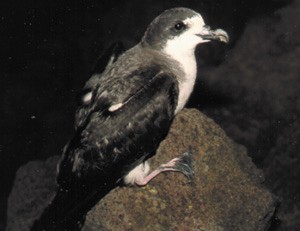|
You are viewing ARCHIVED content published online before January 20, 2025.
Please note that this content is NOT UPDATED, and links may not work. For current information,
visit https://www.nps.gov/aboutus/news/index.htm.

NPS Photo
Contact: Cathleen Natividad Bailey, 808 572-4491 In October and November of each year, young seabirds leave their nests to fly to ocean feeding grounds for the first time in their lives. The endangered ‘ua‘u (Hawaiian petrels) and the non-endangered ‘ua‘u kani (Wedge-tailed shearwaters) leave their nests at night and are thought to use stars to navigate. The birds sometimes become disoriented by lights from land, fly in circles around the lights, become tired and fall to the ground. These "grounded" seabirds are often found on the ground in areas with bright lights such as hotels, golf courses, stadiums and yards lit by floodlights. Most of the grounded birds are found during dark, cloudy nights or nights of the new moon. Lights from land look more like stars during these dark nights than during nights when the moonlight brightens the night sky. This year, biologists are expecting higher numbers of groundings around the time of the new moon on October 22 and the nights around this date. Biologists from Haleakala National Park and the State Department of Land and Natural Resources work together to recover these seabirds. Every year the public plays the most important role in protecting these native birds by reporting any seabirds that become grounded. Biologists are again requesting help from the public in protecting these birds. Anyone finding a grounded seabird is asked to do the following:
‘Ua‘u are black-and-white seabirds with black, webbed feet. They measure approximately 16 inches from beak to tail and have a wingspan of about three feet. These endangered native birds, found only in Hawai'i, nest on the slopes of Haleakala. About ninety percent of the known ‘ua‘u population nests within Haleakala National Park. ‘Ua‘u kani (wedge-tailed shearwaters) are gray and white seabirds that look similar to the ‘ua‘u. They measure about 17 inches from beak to tail and have a wingspan of 38 inches. ‘Ua‘u kani nest at lower elevations on banks and cliffs near the shore with numerous colonies along coastal areas of Maui and on offshore islands. The current ‘ua‘u population is estimated at 2000 individuals. The ‘ua‘u kani population is unknown, but is much larger than the ‘ua‘u population. Both of these native birds are threatened with extinction by habitat loss and predators such as feral cats, dogs, mongooses and rats. The 'ua'u is federally protected under the Endangered Species Act. All seabirds are federally protected under the Migratory Bird Treaty Act. Biologists extend their thanks to the public for their assistance in protecting these native birds. For more information, please call National Park Service Wildlife Biologist Cathleen Natividad Bailey at 572-4491 or State Wildlife Biologist John Medieros 875-3510.
|
Last updated: February 28, 2015
